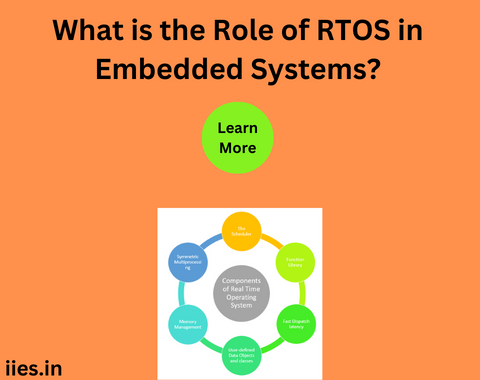
Embedded systems play a crucial role in our daily lives, powering devices ranging from smartphones and smartwatches to medical devices and automotive control systems. To meet the stringent requirements of these diverse applications, Real-Time Operating Systems (RTOS) have become an integral part of embedded systems design. In this article, we will explore the significance of RTOS in embedded systems, their key characteristics, and the challenges and benefits they bring to the table.
A Real-Time Operating System is designed to manage the execution of tasks in real-time applications, where precise timing and reliability are critical. Unlike general-purpose operating systems, such as Linux or Windows, RTOS focuses on meeting strict deadlines and providing deterministic behavior. There are two main types of RTOS: hard real-time and soft real-time.
Hard real-time systems require that tasks meet their deadlines under all circumstances. Missing a deadline can lead to catastrophic consequences, making hard real-time RTOS essential in applications like medical devices, avionics, and automotive safety systems. On the other hand, soft real-time systems prioritize timely execution but allow occasional deadline misses, making them suitable for multimedia applications and certain industrial control systems.
1. Deterministic Behavior:
RTOS ensures deterministic behavior by providing a predictable and guaranteed response time for tasks. This characteristic is crucial for applications where timing precision is paramount, such as control systems in robotics or industrial automation.
2. Task Scheduling:
RTOS employs various scheduling algorithms to manage the execution of tasks. Common scheduling algorithms include Rate Monotonic Scheduling (RMS) and Earliest Deadline First (EDF), which prioritize tasks based on their deadlines.
3. Interrupt Handling:
Embedded systems often rely on interrupts to respond to external events promptly. RTOS is designed to handle interrupts efficiently, minimizing latency and ensuring that critical tasks can be executed without delay.
4. Resource Management:
Efficient resource management is vital in embedded systems to allocate and deallocate resources effectively. RTOS provides mechanisms for managing resources such as memory, CPU time, and peripherals, preventing resource conflicts and enhancing system stability.
5. Real-Time Clocks and Timers:
RTOS incorporates real-time clocks and timers to keep track of time accurately. This feature is essential for applications that require precise time synchronization, such as in the field of telecommunications or distributed control systems.
1. Resource Constraints:
Many embedded systems operate with limited resources, including memory and processing power. Implementing an RTOS in such environments requires careful optimization to ensure efficient resource utilization without compromising performance.
2. Complexity:
RTOS can introduce complexity to the system, especially for developers accustomed to designing applications for general-purpose operating systems. Learning to work with real-time constraints and scheduling can be challenging.
3. Cost:
RTOS solutions may come with licensing costs, which can be a concern for projects with strict budget constraints. Open-source RTOS options, such as FreeRTOS and ChibiOS, provide cost-effective alternatives, but developers must weigh the trade-offs carefully.
1. Predictable Performance:
RTOS guarantees predictable and consistent performance, ensuring that tasks are executed within specified time frames. This predictability is crucial for applications where timing precision is paramount.
2. Improved Responsiveness:
The efficient handling of interrupts and prioritized task scheduling in RTOS results in improved system responsiveness. This is particularly beneficial in applications like real-time control systems and responsive user interfaces.
3. Reliability and Safety:
In safety-critical applications, such as medical devices and automotive systems, the reliability of task execution is paramount. RTOS enhances system reliability by minimizing the likelihood of task deadline misses, contributing to overall system safety.
4. Optimized Resource Utilization:
RTOS optimizes resource utilization by efficiently managing tasks and resources. This is crucial in embedded systems where resources are often limited, ensuring that the system operates efficiently without unnecessary overhead.
Real-Time Operating Systems (RTOS) in Embedded Systems:
A Closer Look In the fast-paced world of technology, embedded systems have become ubiquitous, powering devices that range from the everyday to the extraordinary. Real-Time Operating Systems (RTOS) are the unsung heroes that ensure these embedded systems meet the precise and time-sensitive demands of their applications. Let’s delve deeper into the significance of RTOS, exploring specific applications, key components, and emerging trends in the realm of embedded systems.
Automotive Systems:
In modern vehicles, numerous embedded systems control critical functions such as engine management, braking, and airbag deployment. RTOS ensures that these systems respond to real-time events, contributing to vehicle safety and performance.
Medical Devices:
RTOS plays a pivotal role in medical devices, where accuracy and reliability are paramount. From infusion pumps to patient monitoring systems, RTOS ensures timely and precise execution of tasks, contributing to patient well-being and healthcare efficiency.
Industrial Automation:
Embedded systems are the backbone of industrial automation, controlling processes in manufacturing plants and ensuring seamless operation of machinery. RTOS facilitates real-time control and coordination, optimizing production efficiency.
Telecommunications:
In the telecommunications sector, RTOS is crucial for managing network protocols, ensuring low-latency communication, and handling real-time data streams. This is essential for applications like video conferencing, voice over IP (VoIP), and multimedia streaming.
Real-Time Operating Systems play a pivotal role in the design and implementation of embedded systems, providing the necessary framework to meet stringent real-time requirements. From ensuring predictable performance to improving system responsiveness and reliability, RTOS offers a suite of benefits that make it indispensable in a wide range of applications. While challenges such as resource constraints and complexity exist, the advantages of using RTOS in embedded systems far outweigh the drawbacks, making it a key technology for the future of embedded systems development. As technology continues to advance, RTOS will likely evolve to address emerging challenges and cater to the ever-growing demands of real-time applications.
Indian Institute of Embedded Systems – IIES